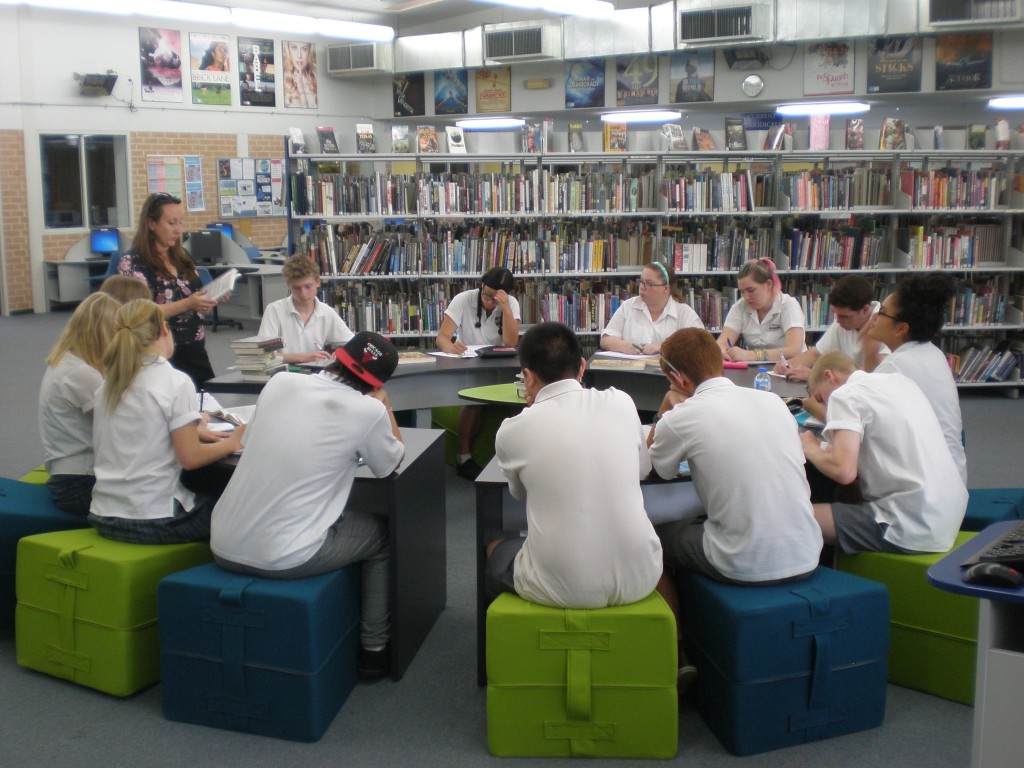- Listening to the voice of the whole community, and using the voice that is given to us;
- Respecting the individual, embracing the human, and creating the space to look within;
- Letting each other do their very best, through being the best that we can be;
- Celebrating our past, discerning our present, and joyfully anticipating our future.
Category Archives: Teacher Librarians
Ammunition for more spending more money on our Libraries
From School Library Journal: USA research on the benefits of school libraries and trained staff.
Reinventing the Library
I read this yesterday and found it interesting despite the clichés
Reinventing the Library – The Intelligencer 2016
This is not your parent’s school library. Students gather at tables or in padded booths to work on projects, watch newscasts on a wall-mounted TV, browse online resources on laptops or even work on a puzzle or print something on a 3D printer.
Gone are the racks and racks of books in neat orderly lines and ever-present librarians ready to shush any student who dares speak louder than a murmur. The commons is a constant buzz of activity and student conversation.
Libraries of the Future
The SMH published a fascinating article by Stephen Heppell who argues that “The traditional environments where teachers and students engage need to improve with move with the times.” Of course we have all seen highly imaginative futuristic articles prophesying about schools in the 21st century and even beyond – not all of which have been compelling – but Heppell’s article is well worth a read.
Slideshare
Library In Namibia
Gateway to the World – A film about the impact of a library, which was made in Namibia last October (2012), has just been brought to my attention through the OZTL-List. I personally found this film to be groundbreaking in changing the lives of people in Namibia for the better. It’s amazing what a library can do.
Why we need great Teacher Librarians in our Schools
We are teachers first – however the role of the teacher in “teacher librarian” is different from that of a classroom-based teacher providing directed face-to-face instruction and is even more crucial as the Australian Curriculum is rolled out.
Inquiry-based learning underpins the key strands of the Australian Curriculum and given their expertise, the teacher librarian should be an across-school leader in helping TEACHERS become familiar with and able to implement this pedagogy. Whether you use a Guided Inquiry model (which is the most effective IMO because it’s underpinned by years of research and supported by a strong scaffold) or a more generic approach, used effectively it also embraces all the general capabilities that accompany the Australian Curriculum.
So, as well as modelling this with students you teach directly, you should be setting up professional learning opportunities for teachers to understand what it looks like in their area and how to adopt it, and working alongside teachers in a collaborative planning and teaching situation so they can implement it successfully. There are some great texts by Kuhlthau, Maniotes and Caspari as well as Alinda Sheerman’s site https://guidedinquirycommunity.pbworks.com (which you need
to join to be able to access.)
Secondly, the Australian Curriculum also identifies a number of cross-curriculum priorities that can also be addressed by the careful selection of resources, print and digital, and because the teacher librarian as a teacher is one of a
few on staff who have a broad overview of the whole curriculum – both linear and across the strands – he/she is in the best position to identify what it currently available and what needs to be provided to meet the needs, interests and abilities of the
collection’s users as well as the demands of the curriculum and the selection criteria of the Collection Policy. Those resources have to fit in with the philosophy of the school, its identified priorities for development as well as meet the special needs not only of particular students but also the situation. THAT takes a teacher’s knowledge of the school population, child development, who to liaise with and so on. Lib techs don’t usually have that sort of specialist knowledge.
Thirdly, it is the teacher librarian’s responsibility as the information services manager to provide equitable intellectual and physical access to those resources and that means much more than downloading prepared records from SCIS. Most schools have their print collections organised to meet the needs of the students and often the “pure Dewey” number is not the best fit for that.
Similarly, digital resources need to meet criteria beyond the technical such as accessible language, appropriate and relevant content, privacy protection, copyright compliance, and an awareness of where embedded links might lead and
the appropriateness of accompanying advertisements and that takes a teacher’s knowledge.
Examining the Standards of Professional Excellence for Teacher Librarians http://www.asla.org.au/policy/standards.aspx would also identify other areas that mean it is the ‘teacher’ in ‘teacher librarian’ which makes the role unique.
Adapted from a post on OZTLnet


